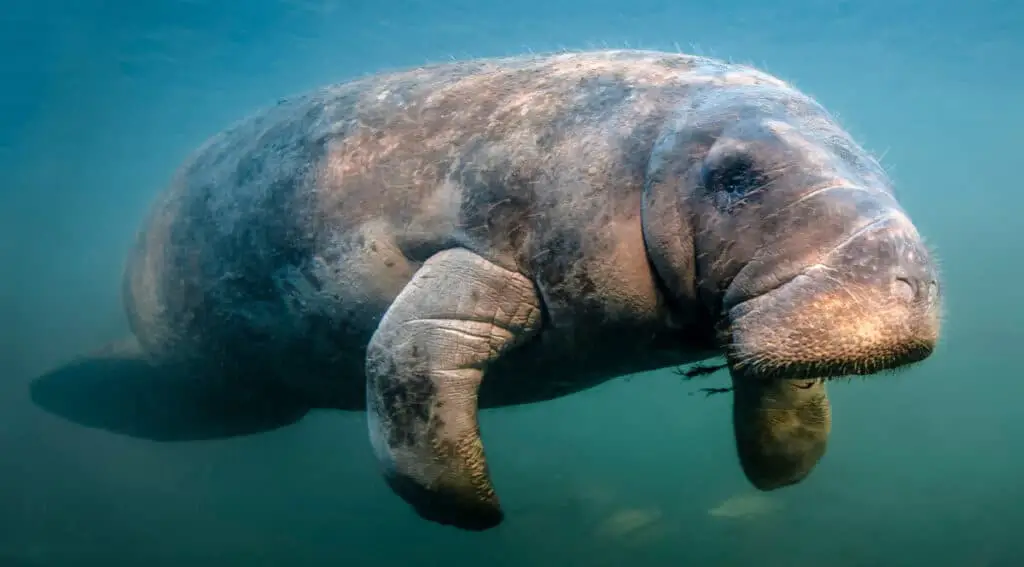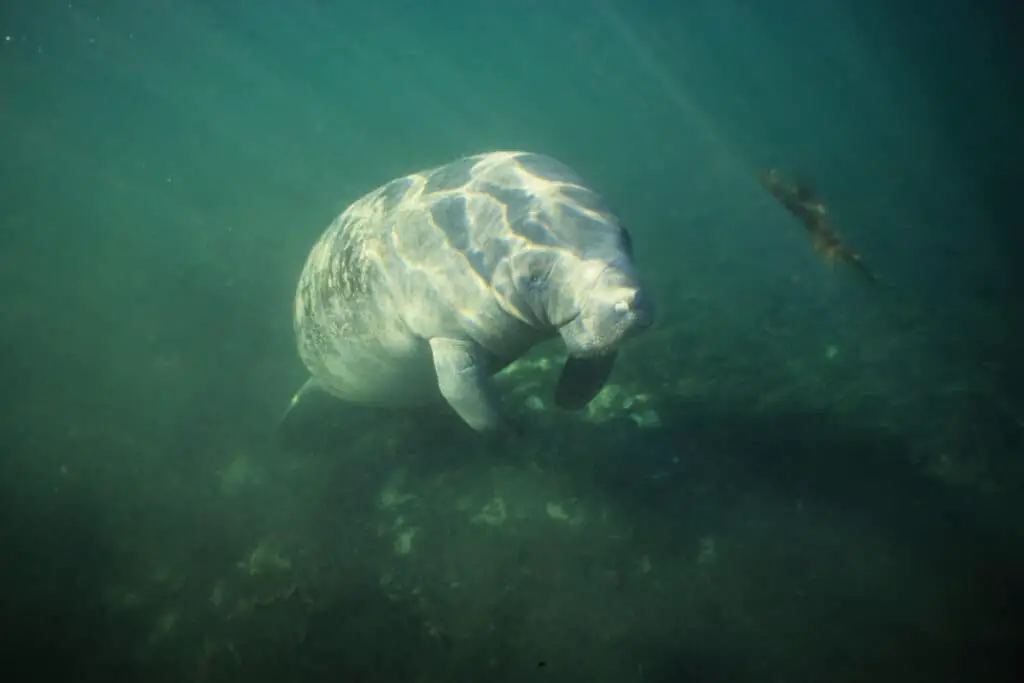Trichechidae is a family of marine mammals that comprises three extant species of manatees, namely the West Indian manatee (Trichechus manatus), the Amazonian manatee (Trichechus inunguis), and the African manatee (Trichechus senegalensis).
These herbivorous mammals are found in shallow coastal waters, estuaries, rivers, and freshwater habitats across their respective ranges. With a unique body morphology adapted to an aquatic lifestyle, they are remarkable animals with important ecological roles.
Manatees have played significant cultural and social roles in many human societies throughout history. They were hunted for meat and oil by indigenous populations as well as European colonizers who encountered them during exploration.
Today, all three Trichechidae species are listed as vulnerable or endangered due to habitat loss, hunting, boat collisions, entanglement in fishing gear, pollution, climate change effects such as sea-level rise and storm surge flooding on their critical habitats. Conservation efforts aim to protect these gentle giants through laws regulating human activities around them and promoting public awareness about their conservation needs.

The Three Species Of Manatees
| Common Name | Scientific Name | Geographic Distribution |
|---|---|---|
| West Indian Manatee | Trichechus manatus | Coastal regions of the southeastern United States, Caribbean, and northeastern South America |
| Amazonian Manatee | Trichechus inunguis | Rivers and freshwater habitats of the Amazon Basin in South America |
| West African Manatee | Trichechus senegalensis | Coastal regions and rivers of West Africa, from Senegal to Angola |
Please note that the taxonomy and geographic distribution of manatees may vary depending on the source and the classification system used.
The Trichechidae family consists of three species of manatees, which are large aquatic mammals. These gentle herbivores can be found in tropical and subtropical waters around the world. They have a unique appearance with their cylindrical bodies, paddle-like flippers, and small eyes that are set far apart on their broad faces.
The population status of each species varies greatly due to human activities such as hunting, habitat loss, and accidental entanglement in fishing gear. The West Indian Manatee is classified as vulnerable by the International Union for Conservation of Nature (IUCN), while the Amazonian Manatee is considered endangered, and the African Manatee is listed as least concern.
Each species has its own specific habitat preferences based on water temperature, salinity levels, food availability, and protection from predators. Understanding these factors is essential for conservation efforts aimed at protecting manatee populations worldwide.
Unique Body Morphology Adapted To Aquatic Lifestyle
Having discussed the three species of manatees in detail, it is now important to delve into their unique body morphology that has been adapted to an aquatic lifestyle.
Manatees belong to the family Trichechidae and are large herbivorous marine mammals found in shallow rivers, estuaries, and coastal areas. They have a fusiform-shaped body with paddle-like flippers and no dorsal fin.
The adaptation mechanisms responsible for this unique morphology can be traced back through their evolutionary history. The ancestors of modern-day manatees were land-dwelling mammals who gradually evolved over millions of years to adapt to an aquatic environment.
Over time, their limbs transformed into paddle-like flippers, which helped them navigate water efficiently while conserving energy. Their smooth cylindrical bodies also reduced drag, making swimming easier. Additionally, they developed specialized lungs capable of holding air for extended periods underwater allowing them to resurface less frequently when searching for food or avoiding predators.
These adaptations have allowed manatees to thrive in their current habitat despite being slow swimmers compared to other marine mammals like dolphins or whales.
Cultural And Social Significance Throughout History
The cultural and social significance of Trichechidae has been prominent throughout history.
On one hand, manatee mythology is prevalent in many cultures around the world. In West African folklore, they are believed to be spirits that protect humans from drowning. Similarly, the Amazonian tribes consider them as sacred creatures with supernatural powers.
On the other hand, Trichechidae art has been popular among different civilizations for centuries. The ancient Mayans depicted these marine mammals in their artwork, often portraying them as deities or symbols of fertility. Additionally, the indigenous people of Florida created wood carvings and pottery featuring manatees, representing their connection to nature and respect for aquatic life.
Today, this artistic representation continues to inspire contemporary artists around the globe.
Threats To Trichechidae Species
Trichechidae species face numerous threats in their natural habitat, including habitat destruction, hunting and poaching.
Habitat loss due to human activities such as coastal development and pollution is a major threat to manatees. Coastal development reduces the availability of suitable habitats for these animals, while pollution from industries and sewage plants contaminates water bodies that serve as feeding grounds for manatees.
Hunting and poaching also pose significant threats to trichechidae populations. Although illegal hunting has been largely curbed across most regions where manatees occur naturally, it still occurs in some areas with lax enforcement measures.
Additionally, accidental trapping or entanglement in fishing nets results in many fatalities each year. It is critical that conservation efforts are stepped up to mitigate these threats and ensure the survival of trichechidae populations worldwide.
Conservation Efforts And Laws
The conservation of trichechidae is of utmost importance, as they are an endangered species with a declining population. Incentivizing tourism can be a viable solution to protecting these gentle giants. For instance, in the West Indian manatee’s habitat in Crystal River, Florida, tourists can view and swim with manatees while also learning about their conservation status and taking part in efforts to protect them.
Furthermore, community involvement is crucial for the preservation of trichechidae. Governments should work closely with local communities to develop sustainable conservation programs that benefit both humans and marine mammals.
Here are three ways that communities can become involved:
1) Establishing sanctuaries or protected areas where trichechidae can safely reproduce and thrive.
2) Educating residents on how to coexist peacefully with manatees through responsible boating practices and avoiding littering in waterways.
3) Encouraging scientific research into better understanding the behavior patterns and needs of these animals so that future policies will be informed by data-driven decisions.
Ultimately, it will take collective action from governments, scientists, locals, and tourists alike to ensure the survival of this beloved sea cow family – Trichechidae.

Public Awareness And Education
Conservation efforts and laws are not enough in protecting the endangered trichechidae, also known as manatees. Public awareness and education play a crucial role in ensuring their survival. By educating the public about the importance of these gentle giants, we can increase support for conservation programs and reduce human-related threats to their existence.
Campaign strategies that aim to raise awareness on manatee conservation have been developed by various organizations such as Save the Manatee Club and SeaWorld Parks & Entertainment. These campaigns often involve social media platforms, information booths at events, and educational resources like posters, brochures, and videos. Educational resources provide vital information on manatee biology, habitat requirements, and threats they face in their natural environment. These materials help people understand how human behaviors can impact manatees’ lives and what actions can be taken to prevent harm.
Overall, through comprehensive campaign strategies backed up with educational resources, public awareness on trichechidae conservation would improve significantly. This will encourage more individuals to become advocates for these marine mammals’ protection while reducing negative human interactions that threaten their continued existence in our oceans’ ecosystems.
Conclusion
Trichechidae, commonly known as manatees, are a group of aquatic mammals that inhabit the waters of North and South America. There are three species within this family, each with their unique characteristics that have allowed them to adapt to life in the water.
One of the most distinctive features of Trichechidae is their body morphology. Their flattened tails act like paddles while their front limbs have evolved into flippers for efficient propulsion through water. This physical adaptation enables these gentle giants to move slowly and gracefully through shallow coastal areas, where they feed on vegetation.
Throughout history, Trichechidae has played an essential cultural and social role in human communities. They were revered by indigenous people as symbols of good fortune and considered sacred animals. However, despite their significance, these majestic creatures face several threats such as habitat loss and boat collisions.
Efforts aimed at conserving Trichechidae species include laws prohibiting hunting or harming these marine mammals; educational campaigns designed to raise awareness about conservation efforts among locals; and research initiatives focused on understanding the biology and ecology of manatees better.
As experts in our field, we recognize that protecting Trichechidae is crucial not only for maintaining biodiversity but also for ensuring sustainable livelihoods for future generations.
In conclusion, just as a mother protects her young from harm’s way, so must we safeguard Trichechidae from potential dangers posed by humans. The survival of these magnificent creatures depends on collective effort towards conservation measures aimed at preserving their habitats and raising public awareness about their importance in our ecosystem. By doing so, we can ensure that future generations will continue to marvel at the beauty and gracefulness exhibited by these gentle giants whenever they cross paths with them in the vast oceanic realm.

